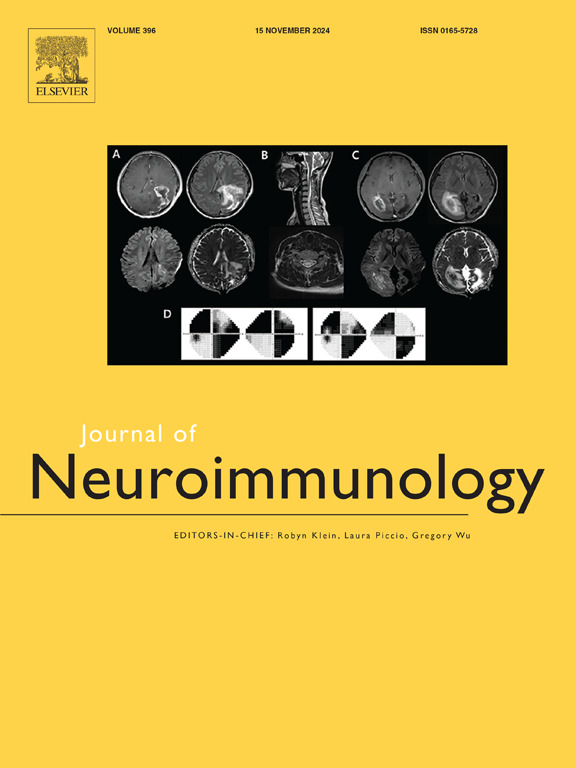Baicalin-Geniposide combination modulates microglia polarization against chronic cerebral ischemia and concomitant kidney injury via the HIF-1α/EPO/NF-κB pathway
IF 2.9
4区 医学
Q3 IMMUNOLOGY
引用次数: 0
Abstract
Background
Baicalin and geniposide combination (BC/GD), a traditional Chinese medicine pairing, is beneficial for chronic cerebral ischemia (CCI) and kidney injury, but the underlying mechanism remains unknown.
Methods
Using network pharmacology, we identified targets and pathways of BC/GD in CCI and kidney injury. Using molecular docking, we discovered the affinity between BC/GD and the key targets HIF-1α, EPOR, and TNF-α. Then, these were verified in SD rats and transwell co-cultures of HMC3 and HK-2 cells.
Results
Experimental validation demonstrated that BC/GD ameliorated cerebral and kidney pathological injury, cognitive impairment, and kidney dysfunction, increased cerebral blood flow, inhibited microglia activation and polarization of pro-inflammatory phenotypes, increased the expression of HIF-1α and EPOR, and reduced the phosphorylation of NF-κB and the level of pro-inflammatory factors in CCI rats. Then, in vitro validation experiments, we found that 12.5 μM and 25 μM BC/GD significantly increased the levels of anti-inflammatory factors and modulated the HIF-1α/EPO/NF-κB pathway in oxygen-glucose-deprived HMC3 and HK-2 cells, which was partially antagonized by PX-478, an inhibitor of HIF-1α.
Conclusion
BC/GD alleviated cerebral and kidney inflammatory injury, and its mechanism may be related to the modulation of microglia polarization through HIF-1α/EPO/NF-κB.

黄芩苷-京尼平苷联合通过HIF-1α/EPO/NF-κB通路调节小胶质细胞极化对抗慢性脑缺血和肾损伤
黄芩苷和京尼平苷联合治疗慢性脑缺血(CCI)和肾损伤是一种有益的中药组合,但其作用机制尚不清楚。方法利用网络药理学方法,确定BC/GD在CCI和肾损伤中的作用靶点和途径。通过分子对接,我们发现BC/GD与关键靶点HIF-1α、EPOR和TNF-α之间存在亲和力。然后,在SD大鼠和HMC3和HK-2细胞的transwell共培养中验证了这些结果。结果BC/GD可改善CCI大鼠脑、肾病理损伤、认知功能障碍和肾功能障碍,增加脑血流量,抑制小胶质细胞活化和促炎表型极化,提高HIF-1α和EPOR的表达,降低NF-κB磷酸化水平和促炎因子水平。在体外验证实验中,我们发现12.5 μM和25 μM BC/GD可显著提高缺氧葡萄糖剥夺HMC3和HK-2细胞的抗炎因子水平,调节HIF-1α/EPO/NF-κB通路,HIF-1α抑制剂PX-478可部分拮抗这种作用。结论bc /GD减轻脑、肾炎性损伤,其机制可能与通过HIF-1α/EPO/NF-κB调控小胶质细胞极化有关。
本文章由计算机程序翻译,如有差异,请以英文原文为准。
求助全文
约1分钟内获得全文
求助全文
来源期刊

Journal of neuroimmunology
医学-免疫学
CiteScore
6.10
自引率
3.00%
发文量
154
审稿时长
37 days
期刊介绍:
The Journal of Neuroimmunology affords a forum for the publication of works applying immunologic methodology to the furtherance of the neurological sciences. Studies on all branches of the neurosciences, particularly fundamental and applied neurobiology, neurology, neuropathology, neurochemistry, neurovirology, neuroendocrinology, neuromuscular research, neuropharmacology and psychology, which involve either immunologic methodology (e.g. immunocytochemistry) or fundamental immunology (e.g. antibody and lymphocyte assays), are considered for publication.
 求助内容:
求助内容: 应助结果提醒方式:
应助结果提醒方式:


